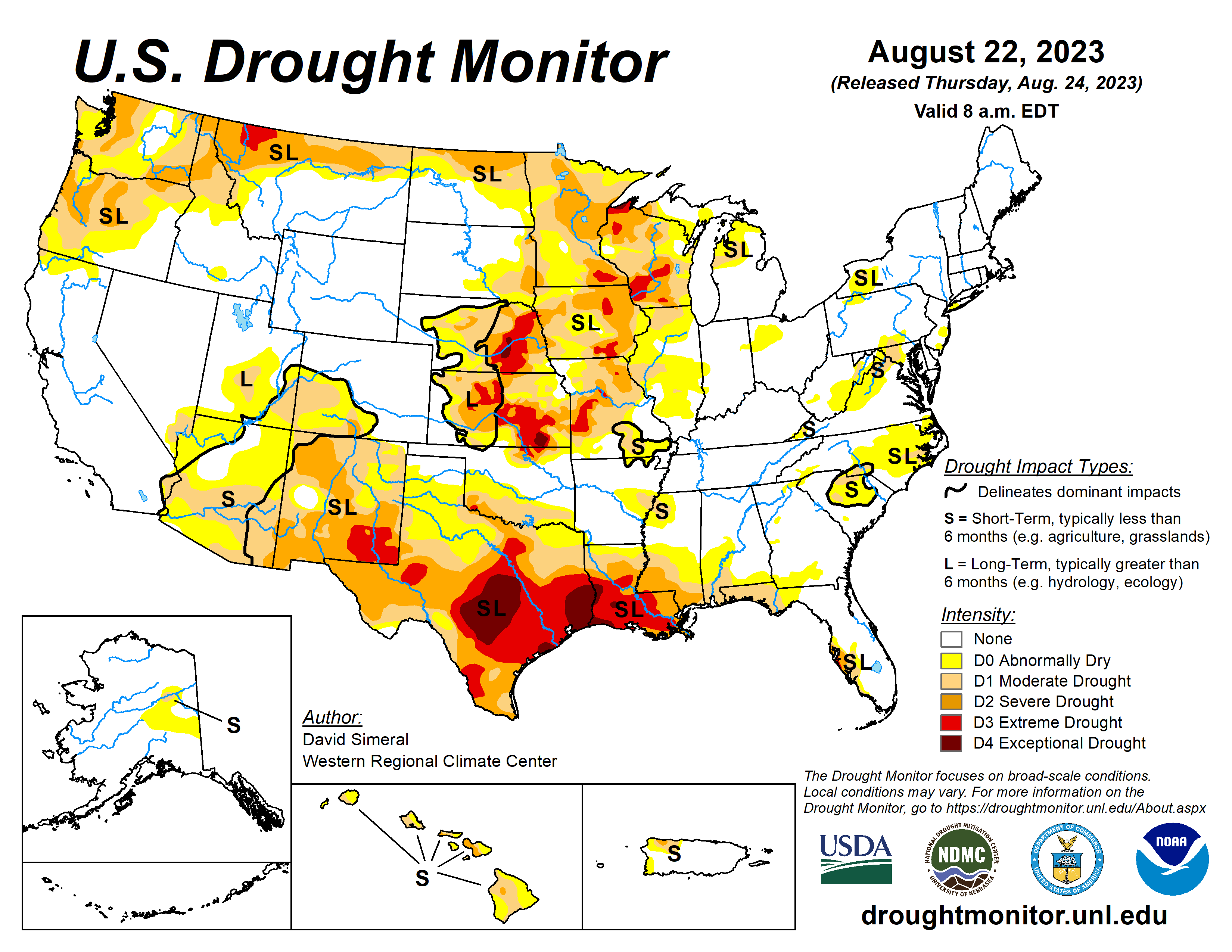In the Southwest, conditions in New Mexico saw statewide degradation on the map in response to a combination of both short- and long-term dryness across the state, including a weak monsoon season with 60-day rainfall deficits ranging from 2 to 6 inches.
In the South, drought-related conditions have deteriorated rapidly during the past month across areas of Texas and Louisiana where persistent heat and rainfall shortfalls have led to drought expansion and intensification on the map this week.
During the past two weeks, average maximum temperatures were 6- to 10- degrees plus Fahrenheit above normal across Texas, southern Oklahoma, Louisiana, and southern Mississippi with reports of impacts related to human health as well as severe impacts to agriculture, vegetation health, and surface water conditions.
Looking at the latest climatological data released by NOAA NCEI (through July 2023), Louisiana Climate Division 7 (Southwest Louisiana) observed its warmest May-July period on record, while Texas Climate Division 8 (Upper Coast) experienced its warmest June-July period on record. In the Midwest, continued areas of dryness led to degradations in portions of Minnesota, Iowa, and Wisconsin.
South
In the South, drought-related conditions continued to deteriorate as the hot and dry pattern continued across most of the region. Many impact reports came in this week emphasizing the rate at which the impact of the persistent heat is taking its toll.
In both Louisiana and areas of Texas, numerous impacts are being observed including declining soil moisture, poor vegetation health, impacts within the agricultural sector, and poor surface and groundwater conditions.
The combination of these factors led to expansive deterioration on the map in areas of Texas, Louisiana, and southern Oklahoma including expansion of areas of Extreme Drought (D3) and the introduction of Exceptional Drought (D4).
For the week, average temperatures across the region were above normal with Louisiana, Oklahoma, and Texas observing temperatures ranging from 4 to 10 degrees above normal.
Conversely, temperatures were near to slightly below normal across northern portions of Arkansas, Mississippi, and Tennessee. In terms of precipitation, the region was very dry except for some isolated areas of South Texas and southeastern Louisiana which received light accumulations.
Midwest
For the week, light precipitation accumulations (<2 inches) were observed across areas of northern Wisconsin, Upper Peninsula Michigan, and northern Michigan. On the map, degradations were made in areas of Minnesota, Wisconsin, and Illinois where both short- and long-term precipitation deficits persist.
Conversely, rainfall during the past 30-60-day period and improving soil moisture and surface water conditions led to removal of areas of Moderate Drought (D1) and Severe Drought (D2) in Michigan.
Average temperatures for the week were below normal (1 to 3 degrees F) across much of the region except for areas of southern Missouri, southern Illinois, and central Wisconsin where temperatures were a few degrees above normal.
High Plains
On this week’s map, no changes were made across the Plains states while some minor improvements were made in northwestern Wyoming and some degradations in south-central Colorado. Across the Plains, hot and dry conditions prevailed across much of the region this week with well-above normal temperatures (2 to 8 degrees) observed, except for areas of the Dakotas where temperatures were a few degrees below normal.
The past 60-day period has been marked with some improvements in response to above-normal precipitation across areas of Kansas and Nebraska. However, the longer-term dry signal has remained intact across areas of the region and continues to be reflected in various drought indicators including soil moisture and streamflow levels.
West
Continued dryness and below-normal streamflow activity led to an introduction of Extreme Drought (D3) in the Northern Rockies around Glacier National Park where streamflows on the North Fork of the Flathead River at Columbia Falls, Montana were in the 4th percentile.
In north-central Montana, areas of Severe Drought (D2) expanded on the map due to a combination of factors including dry soils and below-normal precipitation during the past 60-day period. In the Four Corners states, the poor monsoon season and related precipitation shortfalls led to introduction of areas of Moderate Drought (D1) in southern and central Arizona as well as in south-central Colorado in the San Luis Valley.
In New Mexico, the combination of short- and long-term precipitation deficits, poor soil moisture, and rangeland conditions led to widespread deterioration on the map across much of the state.
Looking ahead
The NWS WPC 7-Day Quantitative Precipitation Forecast calls for light-to-moderate precipitation accumulations ranging from 1 to 3+ inches across portions of the Four Corners states as well as areas of Far West Texas. Likewise, similar accumulations are expected across areas of the Southeast, Mid-Atlantic, and the Northeast.
In the eastern and northern portions of the Midwest, lighter accumulations (under an inch) are forecasted. The CPC 6-10 Day Outlooks call for a moderate-to-high probability of above-normal temperatures across much of the conterminous U.S. including the West, South, Southeast, Plains states, and western portions of the Midwest. Conversely, below-normal temperatures are expected across the Lower Midwest, Mid-Atlantic, and the Northeast.
Below-normal precipitation is expected across the Plains states, Midwest, and far western extent of the Northeast, while above-normal precipitation is forecasted for much of the western U.S. and across much of the Eastern Seaboard.
David Simeral, the author of this week’s summary, is with the Western Regional Climate Center.




